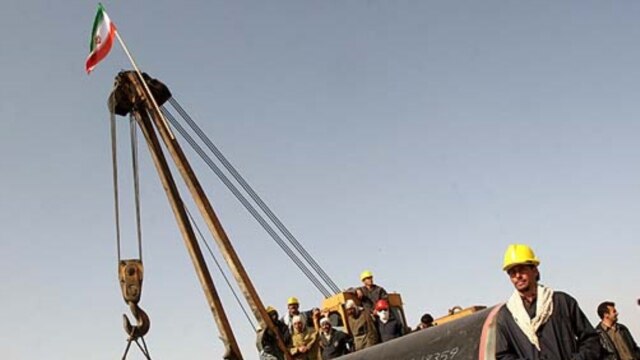It includes some 4,000 square kilometers that stretch within 120 kilometers of the capital, Tehran. Its habitats include desert and steppe that provide homes to hyenas, gazelles, Persian leopards, and Asiatic cheetahs, which Iranian conservationists are battling to protect.
The area has been protected since 1964-65 and was declared a national park and biosphere reserve under the monarchy in 1976.
The daily "Etemad" reported recently that two Iranian Oil Ministry projects would affect the entire area of the park. The ministry reportedly envisages digging for oil and storing gas under the reserve in two projects that would require building pipelines and saltwater canals throughout the park.
But "Etemad" added that those plans had yet to receive the approval of Iranian environmental authorities. The daily said the ministry has had to postpone one oil-exploration project because of resistance from local environmental authorities. The ministry's proposed activities would involve blasting, the digging of exploratory wells, and the construction of pipelines.
Kavir In Peril
"Etemad" and ISNA quoted the head of an Iranian conservation project for the Asiatic cheetah as saying that the injection of 4 billion cubic meters of gas under the national park would force large amounts of saltwater to the surface. That would destroy the park's soil and, presumably, vegetation. The conservationist warned such actions would spark desertification in an area where water is already scarce. He said the projects would damage ongoing or planned ecotourism projects in the Kavir National Park.
A former head of the state environmental authority for the Tehran province, Mohammad Hasan Pirasteh, said the park's environment was already degraded by military exercises, construction of military bases, disrespect for environmental "norms" -- perhaps by seasonal hunters permitted to use the park -- and unspecified "exploitation" of the terrain. Tehran academic and wildlife specialist Esmail Kahrom called the area "very sensitive and important" and cautioned that "if this habitat is destroyed, it is like destroying a house on top of its inhabitants." He argued that "when we commit ourselves in the world to name an area a protected area, it means the area is entrusted to nature alone" and went on to say that "oil exploration and gas storage in the Kavir National Park [would] damage [Iran's] international commitments."
Widespread Disregard For The Environment
The Kavir park situation is not exceptional in Iran. Earlier this year, the government decided to divert water in connection with the Sivand Dam in the southern Fars Province -- against the protests of environmental and heritage activists and at the risk of damaging nearby archaeological sites and grazing grounds.
And the daily "Etemad-i Melli" lamented on August 26 that the government has given the go-ahead for the construction of petrochemicals plants and a refinery in three provinces of the northern Caspian coast. It cited two petrochemical projects in the Golestan and Gilan provinces and a refinery in Mazandaran and expressed alarm that "the location of those projects is none other than the forest and the swamp!" It reported that the petrochemical plant in Gilan -- which it said is on hold -- would destroy 120 hectares of forest if it resumes. Seven to eight hectares have already been razed to start the project.
Hossein Akhani, a botanist and academic from Tehran University has written a long appeal to the head of the state Environment Organization, Fatemeh Vaez-Javadi, to point out the damage to soil, water, and the health of local residents that the Golestan project would cause. Akhani wrote that the swampland of Sufikom, near the planned plant, would dry out and become a dust bowl, "Etemad-i Melli" reported. He wrote that the Golestan petrochemicals plant might generate jobs and money for some, but it would destroy the local environment and lead to long-term and more generalized poverty and sickness for locals. He compared it to the destruction of the Aral Sea in the 1970s by Soviet planners who used that sea's waters to irrigate cotton crops in Central Asia.
Akhani urged Vaez-Javadi to consider the problems that petrochemical pollution has caused to residents of Bandar Abbas in southern Iran and in Tehran. He urged a reconsideration of some of the plans for northern Iran. Akhani said that such projects in his birthplace of Arak have polluted the air and water, and hurt local farming. He suggested that industrialization and the degradation of the environment in Arak have led to rising crime and other local problems.
Akhani noted that "the government and parliament [have] concluded that one has to prevent senseless fuel consumption" and went on to ask why the state is not using the savings from the recent national fuel restrictions to develop agriculture, instead of producing pollutants? "Which is more important," Akhani asked, "food security or the construction of a petrochemicals complex whose technology is foreign and [whose profits] may also go into their pockets?"
The newspaper did not report whether the Environment Organization leadership had replied. But it pointed out that President Mahmud Ahmadinejad's government recently lifted a long-standing ban on large-scale and polluting projects on Iran's northern Caspian coast.
Spike In Birth Defects
"Etemad-i Melli" reported separately that 270 cases of birth defects were registered over a six-month period in the port of Mahshahr in the southwestern Khuzestan Province -- possibly due to oil and related pollutants flowing into the Persian Gulf. The newspaper reported that officials accept that the pollution of local waters is a factor in increased sterility among men and women in Khuzestan, but it noted the lack of any action from the state. It claims that if "anywhere else in the world...a small town and in a period of six months almost 270 children were born with birth defects and sometimes without a head, the country would be thrown upside down and some officials would...be forced to resign." But "Etemad-i Melli" says that "amazingly, this...disaster has occurred in Iran...without [officials] paying much attention."
These cases and Iran's relentless pursuit of what the government asserts is a purely civilian nuclear program highlight the importance that the state assigns to large-scale infrastructure and development projects. The scale, purpose, and seemingly unstoppable advance of such initiatives are at times reminiscent of Soviet or Chinese projects of the 20th century. Indeed, one might plausibly argue that environmental degradation is characteristic of authoritarian governments with leftist leanings, where the state takes a preeminent role in economic development. These recent Iranian moves suggest an ongoing devotion to state-generated industrial development and a rejection -- bordering on contempt or willful ignorance -- of some of the concerns of the early 21st century -- in this case, the environment.
Development -- But For Whose Benefit?
These recent reports also reveal contradictions in the nature of Iran's polity and development. Such projects are ostensibly aimed at benefiting the "people." But one might wonder what their real motive is, if people become sick.
For a polity that declares its concern for piety and the afterlife and praises the culture of martyrdom, it shows an uncommon devotion to earthly prosperity and wasteful development models. Destruction of the environment to produce fuel, plastics, and consumer goods while enhancing the state's capacity to generate cash is surely materialism in one of its most insidious forms.
Given these reports, it seems ironic that Ahmadinejad should have compared, as he did on August 25, Iran's nuclear program to the "confrontation of the culture of the Islamic revolution with the arrogant and material world." His government seems determined to earn cash and put oil money on people's dinner tables -- as he has pledged -- even if swaths of the country are turned into toxic junkyards in the process.
The Post-Soviet Environment
THE FRAGILE PLANET: Since the collapse of the Soviet Union, old environmental disasters have come to light and new ones have emerged. War, poverty, and weak central-government control have led to serious environmental problems from Eastern Europe to the Russian Far East. RFE/RL has provided extensive coverage of these important issues and of efforts to cope with them.
RELATED ARTICLES
Saiga Antelope's Saga Attracts New Allies
Project To Reverse Aral Sea Damage Making Progress
Iraqi Marshes Show Signs Of Strong Recovery
Deforestation Rampant In South And Central Asia
Environmentalist Says BTC Pipeline Could Be 'Death Of Caspian'
Scientists Raise Alarm As Man-Made Deserts Spread
Nature Waits For Cross-Border Sanctuaries To Catch On
Central Asian Vllagers Encouraged To Protect Snow Leopards
Environmentalists Raise Concerns About Russian Ecology Policy



